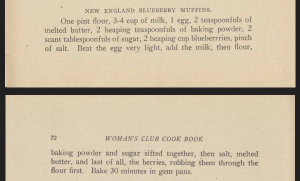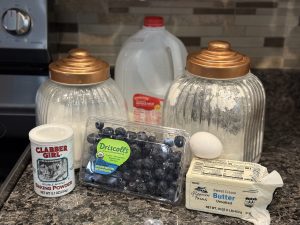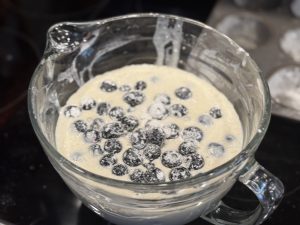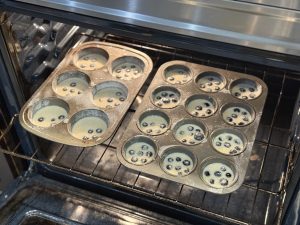This post was guest authored by Alexandra Vargas-Minor, Florida Studies Curator and Campus Archivist at the Nelson Poynter Memorial Library on the St. Petersburg campus
Growing up in a family of bakers, I have always had an affinity for baking and enjoying baked goods. Some of my fondest childhood memories involve helping my mom measure ingredients, sift flour, crack and separate eggs, and shape doughs into their final form. Whether it was rolling rugelach, crushing cookies for cheesecake crusts, shredding coconut for cajeta de coco, or cutting Mendel bread before being baked a second time (and setting aside a batch of soft pieces for myself), baking has always been an expression of my heritage and a bonding activity for my family. My mom always boasts that she doesn’t cut corners and buy pre-made components like pie crusts or cookie dough, and I have adopted a similar motto in my adult life—which has admittedly affected how often I get around to baking.
I particularly appreciate the precision required to follow a recipe and the certainty of the chemistry behind it. Cooking is an art that I have yet to master, largely in part because I am intimidated of the words “season to taste.” I find comfort in the precise measurements, temperatures, and timing that baking requires, so I welcomed the opportunity to try out a new recipe for inclusion in this Digital Dialogs series. My quest to find a recipe for this post was inspired by National Muffin Day on February 20th. Among the abundance of national “holidays,” National Muffin Day stood out to me because of its founders’ philanthropic activities for unhoused people—both by providing baked goods and raising money for their benefit.[1]
THE COOKBOOK
After perusing the USF Libraries’ Historic Cookbook Collection for muffin recipes, I decided to bake the “New England Blueberry Muffins” recipe from the 1908 Woman’s Club Cook Book. As Rebekah Nault wrote in “Baking the Archives: A sweet start for Fall,” the Woman’s Club of Jacksonville tackled a variety of philanthropic initiatives by direct actions that improved the conditions of individuals in their community.[2] Not only did the prospect of baking blueberry muffins sound appealing to me, but the philanthropic goals of the Woman’s Club of Jacksonville paired perfectly with the spirit of National Muffin Day.
THE RECIPE
The “New England Blueberry Muffins” recipe can be found under the “Puddings and Custards” section of the Woman’s Club Cook Book. While the exact origin of muffins is not certain, the sweet baked goods we know today evolved from their English counterparts (a.k.a. English muffins) which are distinguished by their yeast-leavened dough and typically savory taste.[3] Even less information exists about the origin of blueberry muffins, though as Lynne Olver posits in the Food Timeline, we can assume that European settlers adapted their recipes to the ingredients available in the New World.[4] It was common place to add fruits, nuts, and other readily available ingredients to breads, giving way to the blueberry muffins we know and love today.

The elements of this recipe that particularly stood out to me were the imprecise measurements and baking temperature, the lack of vanilla, and the mention of gem pans (which are very similar to muffin pans but are usually cast iron, have more shallow cups, and have cutouts between each cup for even heat distribution).[5] I am no stranger to baking muffins, so the proportion of milk to dry ingredients in this recipe sounded a little puzzling. I was also skeptical about the variable amount of milk required, along with the “heaping” and “scant” qualifiers for the amounts of baking powder and sugar. Furthermore, vanilla was a readily available and mass-produced ingredient by the turn of the 20th century,[6] so I can only assume that the lack of vanilla in this recipe was by design. Despite these details, and the unavailability of true gem pans, I carried on with making the muffins in the muffin tins I had at home.

The recipe itself was brief and straightforward. Recalling my previous venture making blueberry muffins, I opted to use the lower amount of milk to see how the batter turned out before adding more. The final mixture reminded me of pancake batter more than muffin batter, so I held off on adding the fourth cup of milk. The recipe called for rubbing the blueberries in flour before adding them to the batter (which I admittedly skipped last time), so I made sure to do it this time around. Rubbing the blueberries in flour theoretically prevents them from sinking to the bottom of the pan and I was excited to see how successful that would be.

The recipe did not mention anything about flouring the baking pan or setting a specific temperature for the oven. Because of this, I took the liberty of greasing the muffin tins and sprinkling them with flour to prevent the muffins from sticking to the pan. I opted to bake the muffins at 350° since that temperature seems fairly consistent across other muffin recipes. Being unsure of exactly how much the batter would rise, I decided to only fill each muffin tin halfway and used the two different size muffin pans I had on hand.

THE BAKE
The recipe called for a 30-minute bake time. Since I was unsure about the baking temperature, I checked on the muffins at the 15-minute mark and turned the pans around. The kitchen started smelling like blueberry muffins after 20 minutes and I checked on their progress periodically after that. The muffins started to brown at the 25-minute mark, and by the 30-minute mark they looked like they were ready to remove from the oven. I ran a knife around the edges of the cups while the pans were hot and then let them cool on a cooling rack for 10 minutes before removing the muffins from the tin.

I was initially surprised to see that the muffins did not rise very much while baking, so I was a bit disheartened to see that they fell slightly once they cooled. After removing the muffins from the pan and letting them cool for an additional 10 minutes, my curiosity got the better of me and I decided to try one. The texture of the muffins turned out a bit firmer than expected and the flavor was a bland and flour like (which admittedly could have been due to some overzealous flouring of the blueberries and pans). I was most pleased with the distribution of the blueberries throughout the muffins and the flavor they added. I can see how gem pans would come in handy for this particular recipe—this type of pan would have exposed a larger surface area to the oven’s direct heat and allowed the moisture to dissipate. This baking endeavor was mildly successful and yielded more success when the “muffins” were served à la mode. In the end, I would definitely opt to bake a different muffin recipe for the next National Muffin Day.
Want to read more posts like this one?
Read the cookbook!
- Woman’s Club of Jacksonville Florida. (1908). Woman’s Club Cook Book. Historic Cookbook Collection. 9.
https://digitalcommons.usf.edu/cookbooks/9
Want to read more posts like this one?
Explore our Baking the Archives series!
References
[1] Nashua DPHCS. (16 February 2024). National Muffin Day, February 20. Hollis Brookline News. https://hollisbrooklinenewsonline.com/national-muffin-day-february-p7839-216.htm
[2] Nault, R. (22 August 2024). Baking the Archives: A sweet start for Fall. Digital Dialogs. https://lib.usf.edu/digital-dialogs/2024/08/22/baking-the-archives-a-sweet-start-for-fall/
[3] Mason, L. (2023). Muffin. The Oxford Companion to Food (2nd ed.): Oxford University Press. https://www.oxfordreference.com/view/10.1093/acref/9780192806819.001.0001/acref-9780192806819-e-1624.
[4] Olver, L. (1999). About blueberry muffins. Food Timeline. https://www.foodtimeline.org/foodfaq2.html#blueberrymuffins.
[5] Gem & Muffin Pans. (n.d.). The Cast Iron Collector. https://www.castironcollector.com/gems.php
[6] Olver, L. (1999). Vanilla. Food Timeline. https://www.foodtimeline.org/foodfaq2.html#vanilla